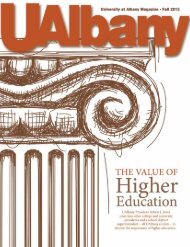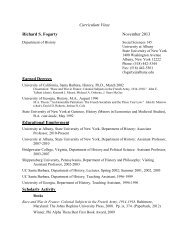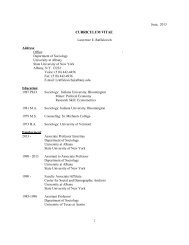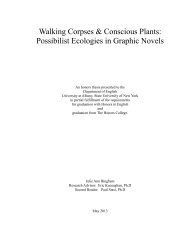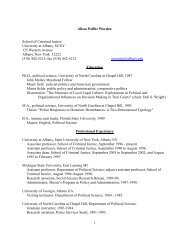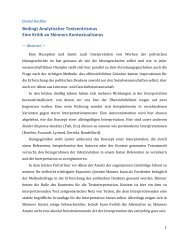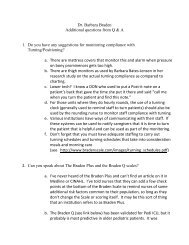Steve Aos - University at Albany
Steve Aos - University at Albany
Steve Aos - University at Albany
You also want an ePaper? Increase the reach of your titles
YUMPU automatically turns print PDFs into web optimized ePapers that Google loves.
Durlauf and Nagin (2010) provide a very useful review and analysis of the research liter<strong>at</strong>ure on the<br />
two sentencing factors th<strong>at</strong> determine a st<strong>at</strong>e’s ADP: the probability of a sentence to prison given a<br />
conviction, and the severity of the sentence in terms of length of prison stay.<br />
Each of these sentencing parameters—the certainty of punishment and the severity of<br />
punishment—are affected by different sentencing policies. Yet, as Durlauf and Nagin found, the<br />
research liter<strong>at</strong>ure indic<strong>at</strong>es th<strong>at</strong> the two types of policies are likely to have quite different effects<br />
on crime. They conclude:<br />
The key empirical conclusion of our liter<strong>at</strong>ure review is th<strong>at</strong> there is rel<strong>at</strong>ively little reliable<br />
evidence of vari<strong>at</strong>ion in the severity of punishment having a substantial deterrent effect but<br />
th<strong>at</strong> there is rel<strong>at</strong>ively strong evidence th<strong>at</strong> vari<strong>at</strong>ion in the certainty of punishment has a<br />
large deterrent effect. 6<br />
Using the Durlauf and Nagin results, one would conclude th<strong>at</strong> the mean ADP elasticity from<br />
equ<strong>at</strong>ion (1) for a sentencing policy th<strong>at</strong> affects the certainty of punishment would be higher.<br />
Conversely, the mean ADP elasticity for a sentencing policy th<strong>at</strong> affects the length of prison stay<br />
would be lower. While the st<strong>at</strong>e of research may not allow a clear deline<strong>at</strong>ion of the magnitude of<br />
these differential effects, the direction seems clear based on the findings of Durlauf and Nagin.<br />
This means th<strong>at</strong> the coefficients obtained from equ<strong>at</strong>ions such as (1) above can be thought of as<br />
only rough guides for the effectiveness of average sentencing changes. Until new research can<br />
address the issues raised, the coefficients obtained from these equ<strong>at</strong>ions need to be adjusted to<br />
better estim<strong>at</strong>e the specific policy choices available to legisl<strong>at</strong>ures. Adjustments need to reflect: (a)<br />
the wide heterogeneity of criminal propensities among offenders, (b) th<strong>at</strong> legisl<strong>at</strong>ures usually adjust<br />
sentencing policies differentially for different types of crimes, and (c), th<strong>at</strong> the particular type of<br />
sentencing policy adopted is likely to affect crime differentially depending on whether the policy<br />
changes the certainty or severity of punishment.<br />
Finally, it is worth re-emphasizing the main concluding point made by Sabol: the inability of most<br />
current research to control for the apparent simultaneity between crime and criminal justice<br />
policies. Crime may be affected by prison, but there is also evidence in many of the studies th<strong>at</strong> the<br />
use of prison is affected by crime. 7 This simultaneous rel<strong>at</strong>ionship, if not accounted for, will<br />
probably bias the coefficient in a model like equ<strong>at</strong>ion (1) downward. If a legisl<strong>at</strong>ure’s willingness to<br />
provide prison cells is motiv<strong>at</strong>ed by changes in crime levels, then the observed rel<strong>at</strong>ionship<br />
between prison and crime can be measuring both prison supply decisions and criminal response to<br />
prison levels. Therefore, an observed effect of prison on crime is likely to be muted because some<br />
of the observed rel<strong>at</strong>ionship reflects the use of more prison as a result of crime changes. As Sabol<br />
notes, technically these models require an exogenous source of vari<strong>at</strong>ion—an instrumental variable<br />
6 S. N. Durlauf & D. S. Nagin (2010). The Deterrent Effect of Imprisonment. N<strong>at</strong>ional Bureau of Economic Research<br />
working paper. http://www.nber.org/confer/2010/CRIs10/Durlauf_Nagin.pdf<br />
7 Marvell, 2009.<br />
6



